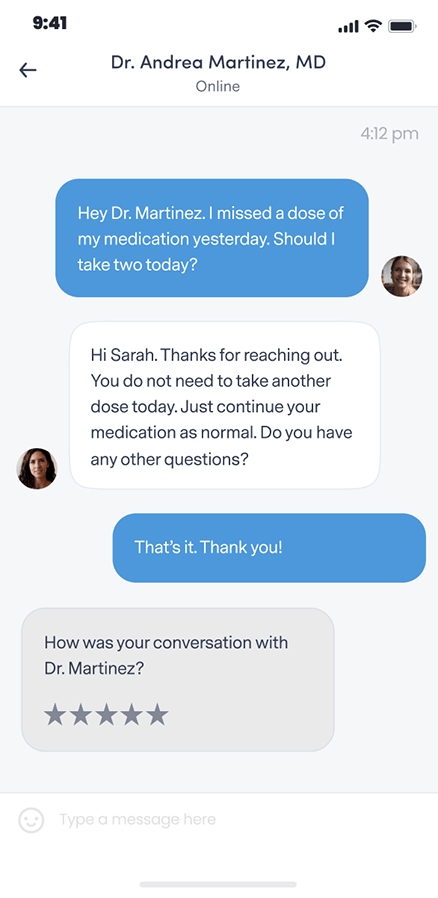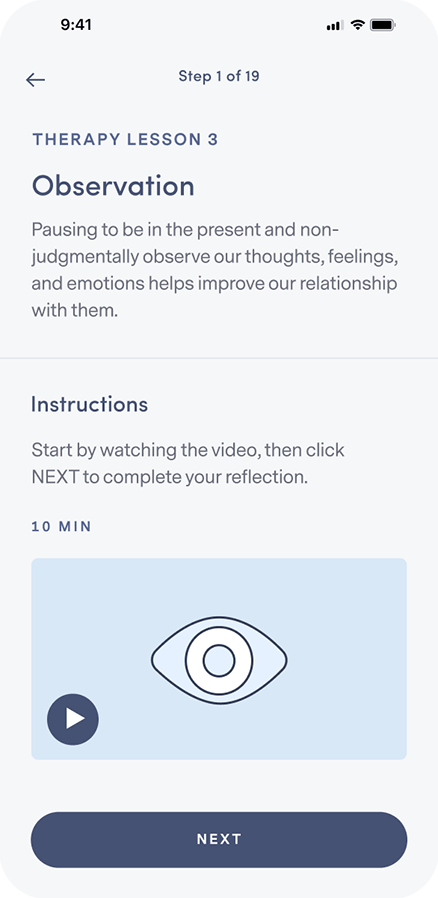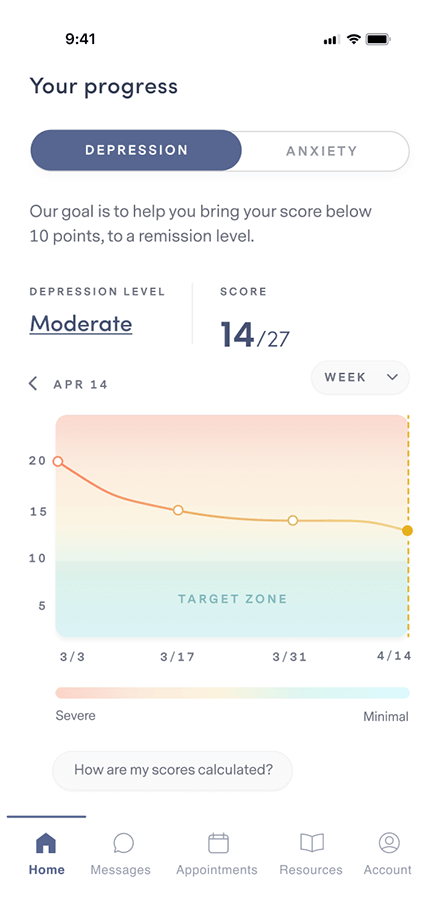HOW WE TREAT PTSD
Life-changing online care for post traumatic stress disorder
Our providers understand the challenges of PTSD, and have real-world experience helping people just like you.
Start with a free assessment
HOW WE TREAT PTSD
Our providers understand the challenges of PTSD, and have real-world experience helping people just like you.
Start with a free assessment
Our Care
Different people experience PTSD in different ways. That’s why our providers work 1:1 with you to personalize treatment to your unique needs.
When medication is necessary, our psychiatric providers analyze 100+ data points to determine the most tolerable and effective prescription for you.
Our program combines cognitive and behavioral therapy with independent skill practice—all of which have been clinically proven to work for a wide range of symptoms.
Mental Health condition
Symptoms of PTSD can begin anywhere from three months to years after the traumatic experience. Symptoms can include flashbacks, bad dreams, avoidance of places or things that remind them of the traumatic event, being easily startled or “on edge,” difficulty sleeping, feelings of guilt or blame, and mood changes.

Post traumatic stress disorder, or PTSD, is a mental health condition that develops after a person has experienced a traumatic or frightening event. While most people feel afraid during and after a traumatic experience, those who have PTSD continue to feel fear long after the event is over and they are no longer in danger.
It’s important to remember that not everyone who experiences PTSD has been in danger. Some people develop symptoms of PTSD after the sudden death of a loved one, or other unexpected trauma.

The symptoms of PTSD are broken out into four categories:
The course of the illness varies, with some people recovering in six months, while others developing chronic, lifelong symptoms.
HOW IT WORKS

Let your provider know how you’re feeling, get to know you, and provide 1:1 support.

Get questions or concerns off your chest between video visits by messaging your provider at any time.

Learn how to integrate new thought and behavior patterns into your daily life.

Complete weekly check-ins so your provider can track your progress and, if necessary, adjust your treatment and/or medication.
Our plan options
Because quality mental health care shouldn’t be out of reach for anyone.
PERSONALIZED
clinically-proven
comprehensive
Free Assessment
86% of our members feel better within 12 weeks.
We accept insurance.





FREQUENTLY ASKED QUESTIONS
If your question isn’t answered below, view our full list of FAQs here.
Brightside is available to people 18 years and older in the states where Brightside operates who believe they may be experiencing depression and may benefit from treatment.
Remote care is not a good fit for people with certain conditions or situations. These include (but are not limited to):
Our providers do not treat, and do not prescribe for adhd.
If any of these describe you, it’s best for you to be seen by a provider in person so you can get the care that’s right for you.
Brightside makes it easy to get top quality depression care from the privacy of home.
Here’s how Psychiatry works:
Here’s how Therapy works:
When scheduling your first appointment, you can browse all of our available providers in your state. Take a look at their profiles and check open times to find the best fit for you. Every Brightside provider undergoes a rigorous hiring and vetting process to ensure the highest quality care.
Brightside currently accepts select insurance plans in various states for payment of your provider’s or therapist’s services. Please see below for a current listing of plans. Brightside may not be included in all plans that each health insurance company offers. Please contact your health insurance plan to verify that your care at Brightside will be covered.
We currently accept the following insurance plans:
If you are a new member signing up for services you can enter your insurance information during the sign-up process. We’ll let you know your eligibility, as well as you estimated co-pays and out-of-pocket costs (if any) before signing-up or scheduling.
We also accept HSA/FSA payment if you have one of those accounts. If you have questions about using your medical or prescription insurance benefits, please contact us by emailing [email protected].
To diagnose PTSD, a healthcare provider must do an evaluation of your symptoms. PTSD is diagnosed if someone experiences all of the following symptoms for a minimum of one month:
The symptoms must also be severe enough that they interfere with your daily life and are causing significant distress.
It’s important to remember that not everyone who lives through a traumatic event will develop PTSD. However, there are certain risk factors that can make someone more likely to develop the condition.
These risk factors include:
It is normal to feel afraid or uneasy following a traumatic event. However, if your symptoms have lasted over a month and are severe enough to interfere with your day-to-day life, you may be suffering from PTSD.
Make an appointment with your healthcare provider to discuss treatment options that may be right for you.
From medication to therapy, there are a variety of treatment options to help with the symptoms of PTSD.
Medication
Several types of medications can help with the symptoms of PTSD. These include antidepressants and anti-anxiety medications. Sertraline (Zoloft) and paroxetine (Paxil) are the two selective serotonin reuptake inhibitor (SSRI) medications FDA-approved to treat the symptoms of PTSD.
You and your healthcare provider can work together to find the right medication for you. Keep in mind that it takes a few weeks to feel the full effects of these medications.
Therapy
Effective therapies for treating PTSD include different types of Cognitive Behavioral Therapy (CBT), such as exposure therapy and cognitive restructuring. Talk therapy is another effective treatment for people struggling with PTSD.
Exposure Therapy
This type of therapy helps someone control their fear in the face of something they’re afraid of. Exposure therapy gradually increases exposure to the trauma experienced in a safe way by using imagination, writing, or visiting the location of the traumatic event. The therapist can then use these tools to help someone develop coping strategies.
Cognitive Restructuring
Cognitive restructuring helps reframe triggering or bad memories into a more realistic memory. Sometimes, people struggling with PTSD won’t correctly remember what happened during the trauma and may feel guilt or shame about their role in the event. This type of therapy helps to restructure memories in a more neutral, less triggering way.
Talk Therapy
Psychotherapy, or talk therapy, can be another effective treatment for PTSD. Talk therapy for PTSD can either occur one on one or in a group setting, and helps people talk through their symptoms.
Talk therapy can teach helpful ways to react to frightening or triggering events by:
Self-Care, Coping, and Support
Many treatment plans for PTSD involve aspects of self-care. This can include: